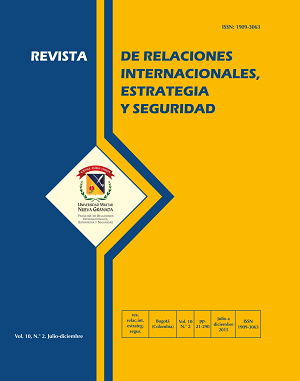The relation between the foreign direct investments and the economic security in Latin America
Abstract
The main objective of the article is to analyse the economic security understood as macroeconomic stability through the following variables: the ratio of foreign direct investment in Latin America with the value of the corruption index, the GINI coefficient and the Gross Domestic Product. The hypothesis is that the higher the GINI coefficient is and lower is the score in the ranking of corruption index according to Transparency International, the country receives greater investment and greater is his level of economic security, even if is not the only condition. We demonstrate empirically, trough econometric analyses, that there is a strong correlation between the mentioned variables in the case of Latin America countries, emphasis on extreme cases of Uruguay and Venezuela and the more moderate of Mexico and Brazil. As far as we know there is no study for Latin American countries, regarding economic security issues, using this methodology, where finally the hypothesis for all the mentioned countries is confirmed.
Downloads
Languages:
enReferences
Balasubramanyan V., Salisu, M., & Sapsford, D. (1996). Foreign Direct Investment and Growth in EP and IS Countries. Economic Journal. (106), 96-105.
Ball, D. et al. (2004). International Business, the challenge of global competition. Mc. Graw Hill: New York.
Cable, V. (1995). What is international economic security? Royal Institute of International Affairs, 71(2), 305-324
Carter, B., & Paul, P. (2015). Why do states build walls? Political Economy, Security, and Border Stability. New Jersey: Princeton University. http://dx.doi.org/10.1177/0022002715596776
Caves, Richard, (1999). Multinational enterprise and economic analysis. Nueva York: Cambridge University Press.
Cruz, J. (2013). La distribución del Ingreso y los modelos de desarrollo en México. México D.F.: Instituto de Investigaciones Económicas.
Cruz, J. (2015). Income Distribution and Poverty as Obstaclesto the Recovery of the European Union. Revista De Relaciones Internacionales, Estrategia y Seguridad, 10(1), 135-158.
Dunning, J. (1988). The eclectic paradigm of international production: a restatement and some possible extensions. Journal of International Business Studies, 19, 1-32.
http://dx.doi.org/10.1057/palgrave.jibs.8490372
Eiteman, D., Stonehill, A. & Moffett, M. (2007). Multinational Business Finance, Nueva Jersey: Pearson.
Findlay, R. (1970). Trade and specialization. Harmondsworth: Penguin Books.
Groot de, O. (2014). Foreign direct investments and welfare. Production Development series. 6-19
Hecksher E., Ohlin B. & Chamberlain E. (1933). International trade in the presence of product differentiation, economies of scale and monopolistic competition: A ChamberlinHeckscher-Ohlin approach. Journal of International Economics, 11(3), 305-340.
Inglehart R. & Abramson P. (1994). Economic security and value changes. American Political Science Review, 88(2), 20-32 http://dx.doi.org/10.2307/2944708
Johanson J. & Valhne, J. (1990). The Mechanism of Internationalization. International Marketing Review, (7), 11-24.
Krugman, P. & Obstfeld, M. (2002). Economía internacional; teoría y política. Madrid: McGraw Hill.
Posner, M. (1961). International trade and technical change. Oxford Economic Papers, 13, 323-341.
Ricardo, D. (1817, 1996). Principles of Political Economy and Taxation, Londres: John Murray Edition.
Rodrik, D. (2001). ¿Por qué hay tanta inseguridad económica en América Latina? Revista de la Cepal, 73. Kojima, K. (1978). Direct Foreign Investment: A Japanese Model of Multinational Business operations, London: Croom Helm Editions. Porter, M. (1987). The competitive advantage of nations. New York: The Free Press Edition.
Kravis, I. (1956). Availability and other influences on the commodity composition of trade. Journal of Political Economy, 64(2), 143-155. http://dx.doi.org/10.1086/257769
Sabino, C. (1999). Democracia y corrupción en América Latina. Revista del CLAD, 40-41.
Scheve, K. & Slaughter, J. (2004). Economic insecurity and the globalisation of production. American Journal of Political Science, 48(4), 62-67. http://dx.doi.org/10.1111/j.0092-5853.2004.00094.x
Shoham, A. (1998). Export performance: A conceptualization and empirical assessment. Journal of international marketing, 6(3), 59-81.
Solow, R. (1957). Technical Change and the Aggregate Production Function. Review of Economics and Statistics, 39(3), 312-320. http://dx.doi.org/10.2307/1926047
Soros, G. (2002). George Soros on Globalization. New York: Public Affairs Edition, Perseus Books Group.
Stiglitz, J. (2003). Globalization and Its Discontents, New York: W. W. Norton Edition.
Zavaleta, S. (2015). El Concepto de Seguridad Humana en la Relaciones Internacionales. Revista de Relaciones Internacionales, Estrategia y Seguridad, 10(1), 65-87.












